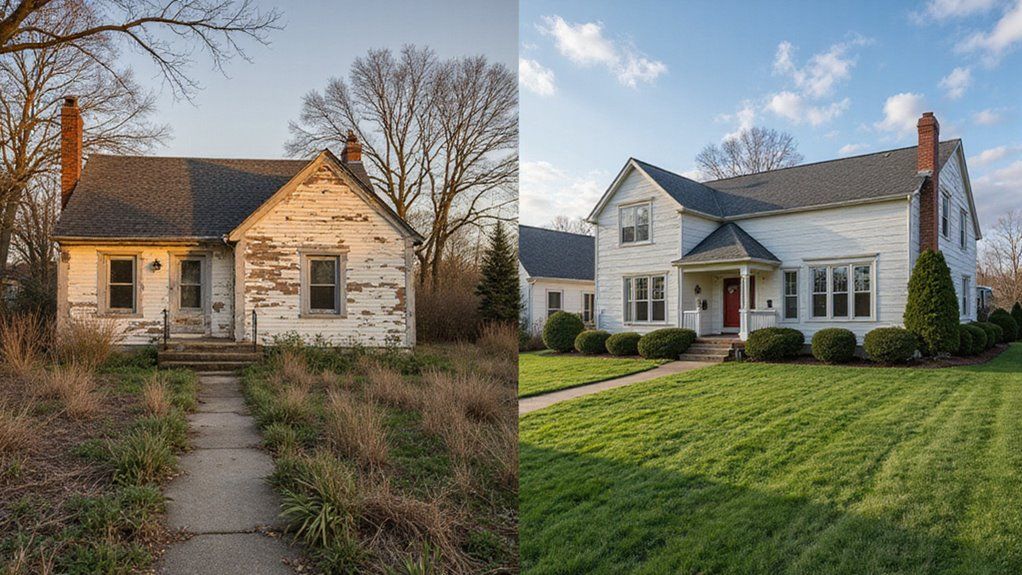How Selling As-Is Compares to Traditional Home Sales

Imagine inheriting a fixer-upper in a quiet suburb, and now you must decide how to sell it. This choice can feel overwhelming as it impacts your time, money, and energy. How do you pick the right path without stress or regret? But here’s the catch: selling as-is means no repairs and a fast close, yet possibly less profit.
A traditional sale might bring more money, but it demands time and costly fixes. This dilemma can leave you stuck and frustrated. Fear not, as there’s a way to decide with clarity.
Selling as-is often suits those prioritizing speed over profit, unlike traditional sales. By comparing both options, you can align your choice with your personal needs and goals. This blog will guide you through these differences to make a confident, informed decision on selling your home.
Key Takeaways
- As-is sales skip repairs, speeding up transactions, while traditional sales often involve staging and fixes for higher offers.
- As-is homes attract fewer buyers, mainly investors, whereas traditional sales draw diverse buyers like families.
- As-is sales may yield lower offers due to property flaws, unlike traditional sales with potential for competitive bids.
- As-is sales reduce seller stress by avoiding repair disputes, while traditional sales require active negotiation and preparation.
- As-is sales offer legal protection by buyer acceptance of condition, whereas traditional sales face risks from contingencies.
What Is As-Is Home Sale?
An "as-is" home sale means buying or selling a property in its present state. The seller makes no repairs or upgrades before closing. You accept all faults or issues as they are. If problems exist, they become your responsibility.
Global practices for "as-is" sales differ across regions. Some countries enforce strict disclosure laws for known defects. Others follow a true buyer-beware approach. If you’re unsure, research local rules to understand the term’s impact. Sellers must still comply with state disclosure requirements to avoid potential legal issues.
Key Features of As-Is Home Sale
When you opt for an as-is home sale, you're stepping into a deal that often promises a fair price, a cash offer, and a faster sale compared to traditional methods. You'll appreciate the simplified process, as it cuts through much of the red tape and repair demands that can slow things down.
However, keep in mind that your buyer pool might be limited, often attracting investors rather than typical homebuyers. This approach also means you can avoid costly repairs and sell the property in its current condition.
Fair Price
Determining a fair price for an as-is home sale starts with understanding its true value. Assess the property’s current condition carefully. Research local market trends to see what similar homes sell for. This helps set a competitive baseline price. If unsure, hire a professional appraiser for an unbiased estimate.
Next, consider appraisal methods to evaluate your home’s worth. Factor in any needed repairs or outdated features. As-is buyers often expect a discount due to flaws. So, avoid setting a price too high. If overpriced, you might scare off potential buyers.
Instead, choose a realistic figure reflecting market rates and issues. This attracts serious interest without losing value. If priced right, your home can sell quickly. Always balance fairness with the property’s actual state.
Cash Offer
Savvy homeowners recognize that cash offers are key in as-is home sales. These deals involve buyers with ready funds. They avoid delays tied to financing issues. If you want a fast sale, this option appeals greatly. Investors often make cash offers to flip or rent homes. They skip the burden of fixing properties.
Cash offers also protect against market changes. If economic conditions shift, traditional sales might fail. A cash deal secures your price early on. It shields you from sudden value drops. When you choose this path, you gain control. You ensure certainty in a shaky real estate world.
Faster Sale
Selling your home doesn’t have to take forever. An as-is sale speeds up the process with quick transactions. You avoid long waits for buyer talks or inspections. Urgent marketing helps attract ready buyers fast.
Here’s why as-is sales are quicker:
- Instant Appeal: Investors often want as-is homes for fast purchases.
- No Fix Waits: If repairs aren’t needed, closing happens sooner.
- Simple Deals: Cash buyers usually make quick, easy offers.
With urgent marketing, you’ll reach these buyers rapidly. If you act now, the deal can close in no time. Take charge and sell when you’re ready!
Simplified Process
An as-is sale offers a fast and easy way to sell your home. It skips complex steps and saves time. You list the property as it is, without fixing anything. This avoids long talks about repairs or updates.
If you follow clear guidance from experts, selling becomes simple. They help you know what to disclose about your home. Transparency reduces confusion and speeds up the process. When you set your own terms, you stay in control. Choosing this method makes selling stress-free and quick.
Limited Buyer Pool
Selling your home as-is limits the number of potential buyers. You attract only those ready for a fixer-upper. This smaller group creates specific challenges for your sale.
Consider these key issues that reduce your market:
- Investors Dominate: Most buyers might be investors hunting deals, not families wanting ready homes.
- Financial Limits: Young buyers often lack money for repairs, so they skip your property.
- Appeal Issues: If your home isn’t updated, showing its value online becomes harder.
These factors shrink your audience, which could delay your sale or lower offers.
Reduced Contingencies
Selling as-is limits your buyer pool but simplifies the sale process. It reduces obstacles that might delay the deal. Buyers often accept higher inspection risks in as-is sales. They know you won’t fix issues found during checks. If problems arise, negotiations become less complicated. This approach can speed up the closing timeline significantly.
Additionally, some buyers may offer financing waivers in as-is deals. They handle funding on their own without loan contingencies. If misunderstandings occur, ensure all terms are clearly stated. By cutting these contingencies, you prioritize speed over higher offers. As-is sales work well for certain specific scenarios.
What is the Traditional Home Selling Process?
The traditional home selling process starts when you decide to sell your home using standard methods. It involves a clear structure that requires careful planning and patience. You begin by listing your property, often with a real estate agent. They help set a fair price based on market trends.
Here are the key steps to follow:
- Staging and Marketing: Enhance your home’s look with staging and hold Open Houses. This attracts more potential buyers.
- Negotiations: Carefully review offers and discuss terms with buyers. If needed, adjust to meet their requests.
- Finalizing the Sale: Prepare for Closing Costs like fees and taxes. Ensure all details are ready for a smooth end.
If you invest time and effort, this process can increase your home’s value. Strategic exposure often brings better offers. Additionally, conventional sales may involve risks from financing contingencies that could delay or derail the transaction.
Key Features of Traditional Home Selling
When you choose traditional home selling, you're aiming for a possibly higher price, but you'll need patience as the process often moves slower. You'll find it's a more involved journey, requiring your active role in repairs, staging, and negotiations.
Still, you’ll attract a broader buyer pool, increasing your chances of finding the right match for your property. Additionally, this method often involves mortgage financing, which can extend closing timelines and introduce potential delays.
Potential for Higher Price
Traditional home sales often bring higher prices than as-is deals. They attract buyers ready to pay more for move-in-ready homes. If you follow market trends, you can meet buyer demand for updated properties.
Here’s why traditional sales usually earn more:
- Staging and Repairs: Investing in updates makes your home shine in a tough market.
- Wider Interest: You draw more buyers who prefer homes needing no extra work.
- Stronger Bargaining: A well-kept home gives you power to ask for a better price.
If you present an appealing home, buyers will likely pay top dollar.
Slower Sale Process
The traditional home selling process often takes longer due to many unpredictable factors. A slow market means fewer buyers are looking for homes. Your property might stay listed for weeks without any offers.
Delays in buyer financing can also stretch the timeline significantly. Inspections and negotiations may cause further holdups in closing the deal. If the market is sluggish, you cannot speed up the process easily.
Unlike faster options, traditional sales require waiting for the right buyer. Setting realistic expectations helps you prepare for this extended journey.
More Involved Process
The traditional home selling process takes significant time and effort. It involves many tasks that need your active participation. Unlike quick sales, you can’t simply list your home and leave. If you choose this path, expect a challenging journey.
Here’s what the detailed process includes:
- Negotiations: You will discuss price, repairs, and terms with buyers repeatedly.
- Legal Checks: Contracts must be reviewed carefully to prevent future issues.
- Home Prep and Visits: Staging your home and hosting showings require constant attention.
If these tasks pile up, they can drain your energy quickly.
Broader Buyer Pool
A traditional home sale opens doors to many potential buyers. This approach connects you with a wide range of people. You’ll attract families, investors, and first-time buyers with different needs. If you list traditionally, your home gains visibility through agents and online platforms. Open houses also help showcase your property to more prospects.
This wider reach can lead to better offers. Your property gets seen by more interested buyers. If demand grows, competitive bids might follow. A broad audience gives you a clear edge. With traditional selling, you won’t miss the best deal possible.
Why Selling A House As-Is Is A Good Option
Selling your house as-is offers clear benefits. You skip costly repairs and save both time and money. If you want a fast sale, this option works well.
Here’s why it might suit you:
- Legal Safety: Buyers accept the home’s condition, protecting you from future claims.
- Plan Freedom: If plans change, you avoid spending on unnecessary fixes.
- Quick Deals: Transactions often close faster without repair disputes.
- Additionally, selling as-is eliminates the stress of real estate commissions by bypassing agents for a direct cash offer.
Conclusion
In conclusion, deciding how to sell your home requires careful thought. If you choose as-is, you might avoid repair stress. Opting for traditional sales could bring higher profits, but it takes more time.
If speed matters, consider that we buy houses for cash. Should you need a quick sale, this option skips delays. As-is sales often suit busy sellers or those with fixer-uppers.
When you’re ready, we at Tulsa Home Buyers can help. If you’re in Tulsa, reach out for a fast, fair offer. Let us guide you through a hassle-free process.
This is paragraph text. Click it or hit the Manage Text button to change the font, color, size, format, and more. To set up site-wide paragrapTulsa Home Buyers • May 7, 2025h and title styles, go to Site Theme.
Ready to work with Tulsa Home Buyers?
Let's connect! We’re here to help.
Send us a message and we’ll be in touch.
Or give us a call today at 111-222-3333


